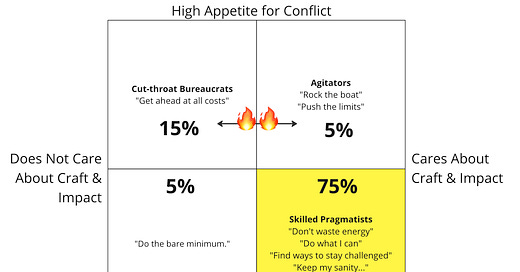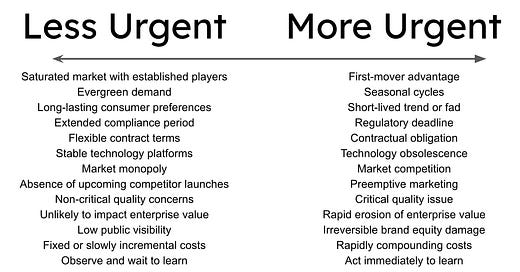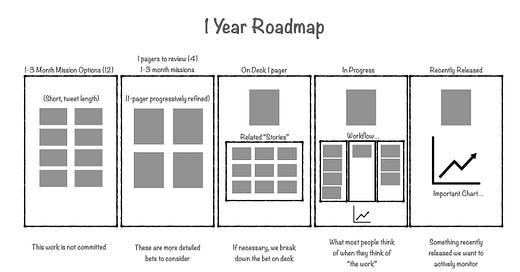
This post is a public service announcement for newsletter readers. I did post normal fair yesterday, but that posted triggered a series of events we should discuss.
Yesterday evening, I spent hours chatting with a frequent newsletter reader. Apparently, they had forwarded the newsletter to a coworker, and this had set off a series of not-good events. Our discussion brought up a lot of thoughts and personal reflection. Thank you for reaching out—you know who you are. Hopefully my advice was helpful.
My newsletter is called The Beautiful Mess. It is for people who enjoy exploring the beautiful mess of collaborative product work. I write about complex organizational dynamics. I write about patterns, conflict, tension, dysfunction, and tactics for my audience to address these challenges.
The ratio is about 60% “think” stuff and 40% frameworks and actionable advice, though a couple of weeks can go by with a heavy skew to one or the other. Before this newsletter, I wrote a couple hundred posts here with a similar skew. One day I will compile all the of actionable advice in a separate resource as it can be hard to find.
So now the PSA.
Be extremely careful about discussing some of the heavier topics in this newsletter with coworkers. I’ve made this mistake repeatedly. So, learn from my mistakes.
Sometimes, talking about a pattern of behavior (the kind we discuss in this newsletter) can be enlightening. But it also can be very dangerous and set back your cause. Giving words to what people have been experiencing or thinking is liberating for some—a catharsis. But for others, it is a reminder of thorny problems they are having difficulty solving or that they have strong feelings on how to solve.
What seems like a universal truth to you (or me) as a student of these dynamics—and the general discourse and research on these topics—may be very foreign to the person you are talking to. Good example: I posted this great piece on Zombie Leadership recently on LinkedIn. It encapsulated discussions I’ve had around leadership with researchers, and other people who dig deeply into these topics. But it challenges very deeply held beliefs.
In short, there is a lot to lose and often little to gain by discussing things as systemic issues, or pointing out patterns of behavior. We should think (and hopefully read, thank you) all we want about the underlying issues but keep that largely to ourselves and share with coworkers who have shown a lot of interest in exploring these topics.
As a general rule, people want things that are non-threatening, easy to parse, and useful in the here and now. You do. I do. Humans do. I don’t mean this in a cynical or patronizing “most people want to preserve the status quo” or “blue pill vs. red pill” way. I’m genuinely saying that given a choice, we prefer things that are more accessible and show quicker results.
For a long time, I preached Why over Way. I thought Why you were doing something was more important than How you did it. And if you could align people on the Why, you would be more successful.
I’ve changed my perspective.
There is a better approach: the Trojan Horse approach.
Find a framework or idea that is largely unthreatening and solves an immediate need. Some examples I’ve come across recently are:
Discussions of cognitive load
Discussing enabling constraints
Team Topologies
Opportunity-Solution Trees
POPCORN flow.
Mandate Levels
North Star Framework
Cynefin, etc.
Cost of Delay
The best Trojan Horse ideas are valuable even to your biggest detractors.
They are safe-to-fail experiments.
Make sure the idea has depth—meaning that as you unravel the layers, you start to chip away at deeper truths. People may arrive at the questions we frequently discuss in this newsletter when they think deeper, but this isn’t a prerequisite for getting value. Avoid shallow ideas that offer a silver bullet, but make sure they provide value. You will know it is valuable based on the discussions that ensue.
And give it a go.
You may feel bad pinning your hopes on a Way. But the Trojan Horse approach is much more likely to work.
/end
















One could expand this advice to the wider political spectrum, in recent times the amount of partisanship in public discourse and within organisations is very high. As you advise it is much better to demonstrate through action, bitesizing change vs trying to somehow convince people through discussion. Not only does that reduce the chance of a potential culture war, it also gives you space to get native with whatever you are recommending. People today have very little in the debate tank these days on all sides, so much better to look for common ground and demonstrate value in a respectful but quietly forceful way. I think we also need to be aware of actors who will look to profit by taking a radical potentially divisive idea and using it to stoke division for another agenda. The political discourse globally and almost war like stance on a wide range of issues means that you are already entering a hostile environment with any change.
It’s a good point. Blogging about something and talking about it in meetings at work are two completely different things.